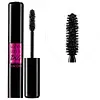Rare Beauty Perfect Strokes Universal Volumizing Mascara Versus Lancôme Monsieur Big Volumizing Mascara
What's inside
What's inside
 Key Ingredients
Key Ingredients

 Benefits
Benefits

 Concerns
Concerns

 Ingredients Side-by-side
Ingredients Side-by-side

Water
Skin ConditioningCopernicia Cerifera Wax
Glyceryl Stearate
EmollientHydrogenated Olive Oil Stearyl Esters
Emulsion StabilisingSynthetic Wax
AbrasiveStearic Acid
CleansingHelianthus Annuus Seed Wax
Skin ConditioningPalmitic Acid
EmollientButylene Glycol
HumectantPolyacrylate-21
Olea Europaea Oil Unsaponifiables
Skin ConditioningAminomethyl Propanol
BufferingRicinus Communis Seed Oil
MaskingSynthetic Beeswax
Emulsion StabilisingPhenoxyethanol
PreservativeCaprylyl Glycol
EmollientGalactoarabinan
Rhus Succedanea Fruit Wax
Shorea Robusta Resin
TonicHydroxyethylcellulose
Emulsion StabilisingSodium Dehydroacetate
PreservativeXanthan Gum
EmulsifyingTrideceth-6 Phosphate
EmulsifyingHydroxyacetophenone
AntioxidantDipropylene Glycol
HumectantGlyceryl Caprylate
EmollientTocopherol
AntioxidantCI 77499
Cosmetic ColorantCI 77007
Cosmetic ColorantWater, Copernicia Cerifera Wax, Glyceryl Stearate, Hydrogenated Olive Oil Stearyl Esters, Synthetic Wax, Stearic Acid, Helianthus Annuus Seed Wax, Palmitic Acid, Butylene Glycol, Polyacrylate-21, Olea Europaea Oil Unsaponifiables, Aminomethyl Propanol, Ricinus Communis Seed Oil, Synthetic Beeswax, Phenoxyethanol, Caprylyl Glycol, Galactoarabinan, Rhus Succedanea Fruit Wax, Shorea Robusta Resin, Hydroxyethylcellulose, Sodium Dehydroacetate, Xanthan Gum, Trideceth-6 Phosphate, Hydroxyacetophenone, Dipropylene Glycol, Glyceryl Caprylate, Tocopherol, CI 77499, CI 77007
Water
Skin ConditioningParaffin
PerfumingPotassium Cetyl Phosphate
EmulsifyingCopernicia Cerifera Cera
EmollientEthylene/Acrylic Acid Copolymer
Emulsion StabilisingStyrene/Acrylates/Ammonium Methacrylate Copolymer
Cera Alba
EmollientSynthetic Beeswax
Emulsion StabilisingBis-Diglyceryl Polyacyladipate-2
EmollientPolybutene
Cetyl Alcohol
EmollientSteareth-20
CleansingGlyceryl Dibehenate
EmollientSteareth-2
EmulsifyingC12-13 Pareth-23
CleansingC12-13 Pareth-3
EmulsifyingTribehenin
EmollientAcacia Senegal Gum
MaskingGlyceryl Behenate
EmollientSodium Laureth Sulfate
CleansingSilica
AbrasiveDivinyldimethicone/Dimethicone Copolymer
Disodium EDTA
Hydrogenated Jojoba Oil
AbrasiveHydrogenated Palm Oil
EmollientHydroxyethylcellulose
Emulsion StabilisingCaprylyl Glycol
EmollientTetrasodium EDTA
Ethylenediamine/Stearyl Dimer Dilinoleate Copolymer
Skin ConditioningButylene Glycol
HumectantBHT
AntioxidantPentaerythrityl Tetra-Di-T-Butyl Hydroxyhydrocinnamate
AntioxidantPotassium Sorbate
PreservativeSodium Dehydroacetate
PreservativePhenoxyethanol
PreservativeWater, Paraffin, Potassium Cetyl Phosphate, Copernicia Cerifera Cera, Ethylene/Acrylic Acid Copolymer, Styrene/Acrylates/Ammonium Methacrylate Copolymer, Cera Alba, Synthetic Beeswax, Bis-Diglyceryl Polyacyladipate-2, Polybutene, Cetyl Alcohol, Steareth-20, Glyceryl Dibehenate, Steareth-2, C12-13 Pareth-23, C12-13 Pareth-3, Tribehenin, Acacia Senegal Gum, Glyceryl Behenate, Sodium Laureth Sulfate, Silica, Divinyldimethicone/Dimethicone Copolymer, Disodium EDTA, Hydrogenated Jojoba Oil, Hydrogenated Palm Oil, Hydroxyethylcellulose, Caprylyl Glycol, Tetrasodium EDTA, Ethylenediamine/Stearyl Dimer Dilinoleate Copolymer, Butylene Glycol, BHT, Pentaerythrityl Tetra-Di-T-Butyl Hydroxyhydrocinnamate, Potassium Sorbate, Sodium Dehydroacetate, Phenoxyethanol
 Reviews
Reviews

Ingredients Explained
These ingredients are found in both products.
Ingredients higher up in an ingredient list are typically present in a larger amount.
Butylene Glycol (or BG) is used within cosmetic products for a few different reasons:
Overall, Butylene Glycol is a safe and well-rounded ingredient that works well with other ingredients.
Though this ingredient works well with most skin types, some people with sensitive skin may experience a reaction such as allergic rashes, closed comedones, or itchiness.
Learn more about Butylene GlycolCaprylyl Glycol is a humectant and emollient, meaning it attracts and preserves moisture.
It is a common ingredient in many products, especially those designed to hydrate skin. The primary benefits are retaining moisture, skin softening, and promoting a healthy skin barrier.
Though Caprylyl Glycol is an alcohol derived from fatty acids, it is not the kind that can dry out skin.
This ingredient is also used as a preservative to extend the life of products. It has slight antimicrobial properties.
Learn more about Caprylyl GlycolHydroxyethylcellulose is used to improve the texture of products. It is created from a chemical reaction involving ethylene oxide and alkali-cellulose. Cellulose is a sugar found in plant cell walls and help give plants structure.
This ingredient helps stabilize products by preventing ingredients from separating. It can also help thicken the texture of a product.
This ingredient can also be found in pill medicines to help our bodies digest other ingredients.
Learn more about HydroxyethylcellulosePhenoxyethanol is a preservative that has germicide, antimicrobial, and aromatic properties. Studies show that phenoxyethanol can prevent microbial growth. By itself, it has a scent that is similar to that of a rose.
It's often used in formulations along with Caprylyl Glycol to preserve the shelf life of products.
This ingredient is a preservative with antimicrobial properties. It is the sodium salt of dehydroacetic acid.
It is especially effective at preventing bacterial and fungal growth in low concentrations.
Synthetic beeswax is created to be identical in structure to beeswax. It possesses the same occlusive and emulsion properties.
A blend of fatty acid esters, fatty acids, and alcohols are used to create synthetic beeswax. Whether or not this ingredient is vegan depends on the source. Sometimes, lanolin is used for its creation.
This ingredient may not be Malassezia folliculitis, or fungal-acne safe.
Learn more about Synthetic BeeswaxWater. It's the most common cosmetic ingredient of all. You'll usually see it at the top of ingredient lists, meaning that it makes up the largest part of the product.
So why is it so popular? Water most often acts as a solvent - this means that it helps dissolve other ingredients into the formulation.
You'll also recognize water as that liquid we all need to stay alive. If you see this, drink a glass of water. Stay hydrated!
Learn more about Water